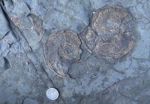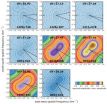(Press-News.org) It is well known that horses show symptoms of stress when ridden but relatively little attention has been paid to the effects on their riders. This is surprising, as equestrian sports rely on the close cooperation between the animals and their riders. How does the horse-rider team cope with the stress involved in competing in an equestrian event?
The issue has now been studied by Mareike von Lewinski in the group of Christine Aurich at the University of Veterinary Medicine, Vienna (Vetmeduni Vienna), together with colleagues at the Vetmeduni Vienna and at the Ecole Nationale d'Equitation in Saumur, France. The scientists measured the changes in various stress-related parameters, such as the level of stress hormones in saliva and the regularity of the pulse, in horses and their riders when the animals were ridden in a particular show programme. The measurements were taken both when the presentation was completed in front of about a thousand spectators and when the riders practised beforehand without any spectators. The results were compared to assess how the riders and their mounts responded to the presence of the audience.
In line with previous experiments, the researchers could observe symptoms of stress – higher cortisol concentrations in the saliva and more irregular heartbeats – both in horses and in their riders during the study. Furthermore, the riders showed significantly higher levels of stress when an audience was present, confirming what was suspected: participation in equestrian events is associated with stage fright, even in experienced riders. There are many reasons why riders might be more stressed when performing in front of an audience than when they are practising for an event – as Aurich says, "they are only human, after all." In contrast, the horses appeared not to be affected by the presence of spectators: their reaction to the course was essentially independent of whether an audience was present or not. In other words, the horses and their riders respond differently to the challenges posed by performing for spectators, with the horses not suffering from the increased levels of stress shown by their riders.
The results imply that the riders do not communicate their heightened anxiety to the animals. The lack of transfer of emotions between rider and horse was completely unexpected. Aurich concedes that "we started with the assumption that the rider's stress would affect his horse but this does not seem to be the case. Nevertheless, we should bear in mind that we were working with experienced horses and highly skilled riders: our findings cannot be generalized to inexperienced riders, who might be less able to prevent their horses from being stressed by the situation."
###
The paper "Cortisol release, heart rate and heart rate variability in the horse and its rider:
Different responses to training and performance" by Mareike von Lewinski, Sophie Biau, Regina Erber, Natascha Ille, Jörg Aurich, Jean-Michel Faure, Erich Möstl and Christine Aurich has just been published online by the "Veterinary Journal". The work was carried out at the Graf Lehndorff Institute for Equine Science, a joint research unit of the University of Veterinary Medicine, Vienna and the Brandenburg State Stud at Neustadt (Dosse), Germany and at the Ecole nationale d`équitation in Saumur, France
Abstract of the original article online (full text for a fee or with a subscription):
http://dx.doi.org/10.1016/j.tvjl.2012.12.025
Horses don't have stage fright -- but their riders do
2013-02-19
ELSE PRESS RELEASES FROM THIS DATE:
Don't trust liposomes in your beauty products
2013-02-19
Liposomes are small fat capsules, often added to beauty products.
According to the beauty industry liposomes are capable of transporting active ingredients deep into the skin and release the active ingredients so that they can alter the skin´s structure by rejuvenating and smoothing the skin.
Research from University of Southern Denmark now shows that liposomes are not capable of transporting themselves deep into the skin, and thus they are not capable of transporting active ingredients deep into the skin.
"We have shown that liposomes are destroyed before they ...
Nicotine lozenges, tobacco-free snuff help smokeless tobacco users quit, Mayo Clinic finds
2013-02-19
ROCHESTER, Minn. -- Smokeless tobacco users who said they didn't want to quit changed their minds or significantly cut back when given nicotine lozenges or tobacco-free snuff in a Mayo Clinic study. The findings are published in the February issue of Addictive Behaviors.
Mayo researchers recruited 81 users of chewing tobacco or snuff with no intention of quitting in the next 30 days. Forty were given 4-mg nicotine lozenges and 41 received tobacco-free snuff to help cut back their smokeless tobacco use. They were asked to cut back 50 percent by one month and 75 percent ...
Fungi offers new clues in asthma fight, say Cardiff scientists
2013-02-19
Hundreds of tiny fungal particles found in the lungs of asthma sufferers could offer new clues in the development of new treatments, according to a team of Cardiff University scientists.
In the first large study of its type, published in the journal, BMC Infectious Diseases, a team of researchers from Cardiff University's School of Medicine have uncovered large numbers of fungi present in healthy lungs.
"Historically, the lungs were thought to be sterile," according to Dr Hugo van Woerden from Cardiff University's Institute of Primary Care and Public Health, who led ...
Is there a link between coffee drinking and mortality?
2013-02-19
New Rochelle, NY, February 19, 2013–A large study of nearly half a million older adults followed for about 12 years revealed a clear trend: as coffee drinking increased, the risk of death decreased. Study author Neal Freedman, PhD, MPH, National Cancer Institute, discusses the significance of these findings and the potential links between coffee drinking, caffeine consumption, and various specific causes of disease in an interview in Journal of Caffeine Research, a peer-reviewed journal from Mary Ann Liebert, Inc., publishers. The article is available free on the Journal ...
Fear, anger or pain -- Why do babies cry?
2013-02-19
VIDEO:
Spanish researchers have studied adults’ accuracy in the recognition of the emotion causing babies to cry. Eye movement and the dynamic of the cry play a key role in recognition.
Click here for more information.
Spanish researchers have studied adults' accuracy in the recognition of the emotion causing babies to cry. Eye movement and the dynamic of the cry play a key role in recognition.
It is not easy to know why a newborn cries, especially amongst first-time ...
Study shows reduced risk of preterm birth for pregnant women vaccinated during pandemic flu
2013-02-19
ATLANTA- Pregnant women who received the H1N1 influenza vaccine during the 2009 pandemic were less likely to have premature babies, and their babies weighed more on average.
Influenza infection during pregnancy is associated with adverse infant outcomes such as preterm birth. Emory researchers from the Rollins School of Public Health, in a joint study with Kaiser Permanente of Georgia and the Mid-Atlantic States, evaluated the effectiveness of the H1N1 influenza vaccine in pregnant women against adverse infant outcomes during the 2009 pandemic. They compared birth outcomes ...
Jurassic records warn of risk to marine life from global warming
2013-02-19
Researchers at Plymouth University, UK, believe that findings from fieldwork along the North Yorkshire coast reveal strong parallels between the Early Jurassic era of 180 million years ago and current climate predictions over the next century.
Through geology and palaeontology, they've shown how higher temperatures and lower oxygen levels caused drastic changes to marine communities, and that while the Jurassic seas eventually recovered from the effects of global warming, the marine ecosystems that returned were noticeably different from before.
The results of the Natural ...
Towards a new moth perfume
2013-02-19
A single mutation in a moth gene has been shown to be able to produce an entirely new scent. This has been shown in a new study led by researchers from Lund University in Sweden. In the long run, the researchers say that the results could contribute to tailored production of pheromones for pest control.
Male moths can pick up the scent of a female moth from a distance of several hundred metres. The females produce sexual pheromones – scent substances that guide the males to them. There are around 180 000 species of moth and butterfly in the world, and most of them communicate ...
Radio telescope, GPS use ionosphere to detect nuclear tests
2013-02-19
WASHINGTON--U.S. Naval Research Laboratory radio astronomer, Joseph Helmboldt, Ph.D., and researchers at Ohio State University Department of Civil, Environmental and Geodetic Engineering analyzed radio telescope interferometry and Global Positioning Satellite (GPS) data recorded of the ionosphere during one of the last underground nuclear explosions (UNEs) in the U.S., codenamed Hunters Trophy.
Situated in the Plains of San Agustin, 50 miles west of Socorro, New Mexico, twenty-seven 25-meter parabolic dish antennas collectively make up the National Radio Astronomy Observatory's ...
Private Security Industry must be made transparent and accountable, study concludes
2013-02-19
The true cost of war is being masked by the secretive and largely unaccountable activities of a private security industry, according to a new study.
These invisible costs of war – both in terms of casualties and financial resources – are not reported and are hard to find because contractors are not subject to the same reporting structures and laws as the regular military, and many of their activities are protected from Freedom of Information requests.
Private security firms – usually run by former senior figures in the military, civil service or politics – are increasingly ...



